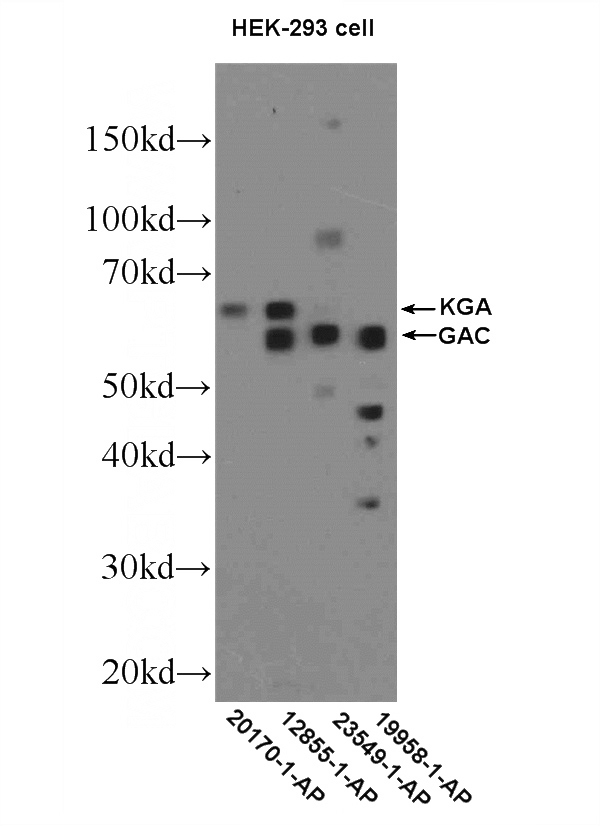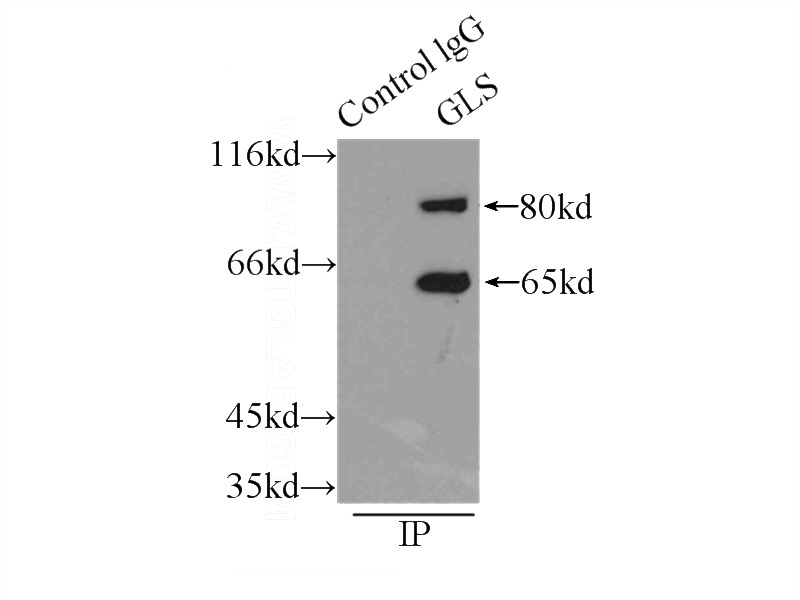-
Product Name
KGA/GAC antibody
- Documents
-
Description
KGA/GAC Rabbit Polyclonal antibody. Positive WB detected in HEK-293 cells, mouse brain tissue, mouse kidney tissue. Positive IP detected in mouse brain tissue. Positive IHC detected in human gliomas tissue, human brain tissue, human kidney tissue. Observed molecular weight by Western-blot: 65kd,58kd
-
Tested applications
ELISA, IHC, IP, WB
-
Species reactivity
Human,Mouse,Rat; other species not tested.
-
Alternative names
AAD20 antibody; DKFZp686O15119 antibody; FLJ10358 antibody; GAC antibody; GLS antibody; GLS1 antibody; glutaminase antibody; K glutaminase antibody; KGA antibody; KIAA0838 antibody; L glutamine amidohydrolase antibody
-
Isotype
Rabbit IgG
-
Preparation
This antibody was obtained by immunization of KGA/GAC recombinant protein (Accession Number: NM_014905). Purification method: Antigen affinity purified.
-
Clonality
Polyclonal
-
Formulation
PBS with 0.1% sodium azide and 50% glycerol pH 7.3.
-
Storage instructions
Store at -20℃. DO NOT ALIQUOT
-
Applications
Recommended Dilution:
WB: 1:200-1:2000
IP: 1:200-1:2000
IHC: 1:20-1:200
-
Validations

Immunohistochemical of paraffin-embedded human gliomas using Catalog No:112033(GLS antibody) at dilution of 1:100 (under 10x lens)

HEK-293 cells were subjected to SDS PAGE followed by western blot with Catalog No:112033(GLS Antibody) at dilution of 1:600

IP Result of anti-GLS (IP:Catalog No:112033, 4ug; Detection:Catalog No:112033 1:500) with mouse brain tissue lysate 8000ug.
-
Background
GLS, also named as GLS1 and KIAA0838, belongs to the glutaminase family. It catalyzes the first reaction in the primary pathway for the renal catabolism of glutamine. Glutaminase-, glutamate-, and taurine-immunoreactive neurons develop neurofibrillary tangles in Alzheimer's disease(PMID:1672808).The glutaminase band in AA/C1 cells is more intense than in HT29 cells, in accordance with measurements of glutaminase activity, and had the same molecular mass of approx. 63 kDa. The bands for both cell lines are clearly different in size from both rat liver glutaminase (58 kDa) and rat kidney glutaminase (65 kDa)(PMID:12408749). It also reveals a molecular weight of 83-84 kDa as a phosphate-dependent glutaminase(PMID:447624;7512428). It has 3 isoforms named as KGA, GAM, GAC. This antibody can recognize KGA and GAC.
-
References
- Colombo SL, Palacios-Callender M, Frakich N. Anaphase-promoting complex/cyclosome-Cdh1 coordinates glycolysis and glutaminolysis with transition to S phase in human T lymphocytes. Proceedings of the National Academy of Sciences of the United States of America. 107(44):18868-73. 2010.
- Shimmura C, Suzuki K, Iwata Y. Enzymes in the glutamate-glutamine cycle in the anterior cingulate cortex in postmortem brain of subjects with autism. Molecular autism. 4(1):6. 2013.
- Xu FF, Huang Y, Wang XQ, Qiu YH, Peng YP. Modulation of immune function by glutamatergic neurons in the cerebellar interposed nucleus via hypothalamic and sympathetic pathways. Brain, behavior, and immunity. 38:263-71. 2014.
- Masamha CP, Xia Z, Yang J. CFIm25 links alternative polyadenylation to glioblastoma tumour suppression. Nature. 510(7505):412-6. 2014.
- Yeo H, Lyssiotis CA, Zhang Y. FoxO3 coordinates metabolic pathways to maintain redox balance in neural stem cells. The EMBO journal. 32(19):2589-602. 2013.
- Oricchio E, Papapetrou EP, Lafaille F. A cell engineering strategy to enhance the safety of stem cell therapies. Cell reports. 8(6):1677-85. 2014.
- Yang HW, Kim TM, Song SS. A small subunit processome protein promotes cancer by altering translation. Oncogene. 34(34):4471-81. 2015.
- Karner CM, Esen E, Okunade AL, Patterson BW, Long F. Increased glutamine catabolism mediates bone anabolism in response to WNT signaling. The Journal of clinical investigation. 125(2):551-62. 2015.
Related Products / Services
Please note: All products are "FOR RESEARCH USE ONLY AND ARE NOT INTENDED FOR DIAGNOSTIC OR THERAPEUTIC USE"
